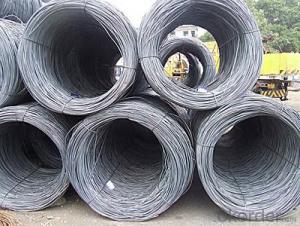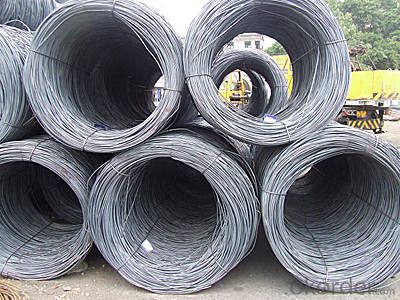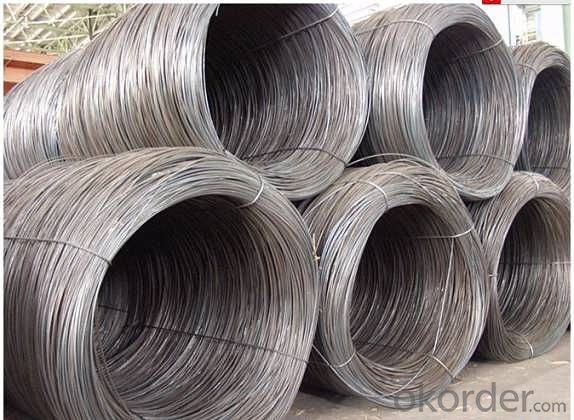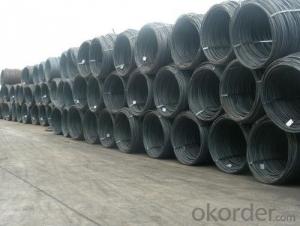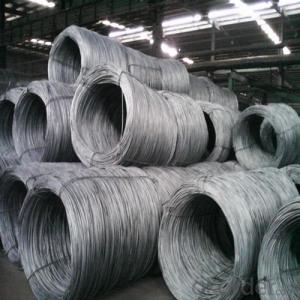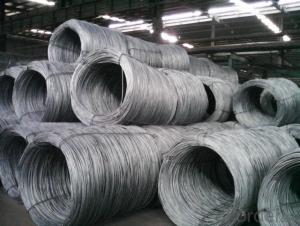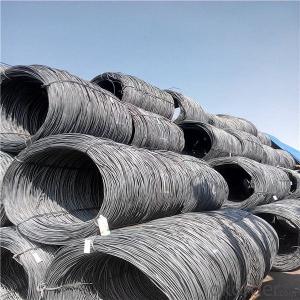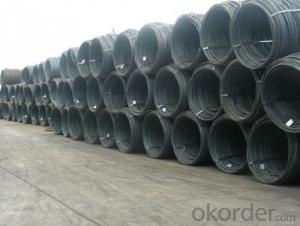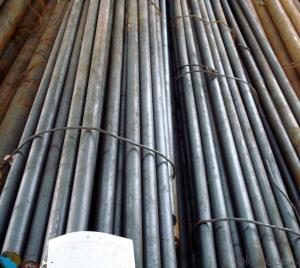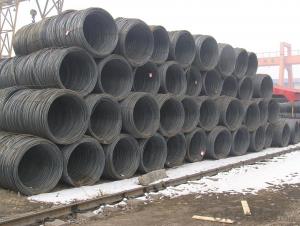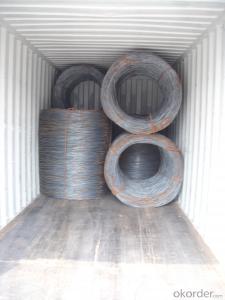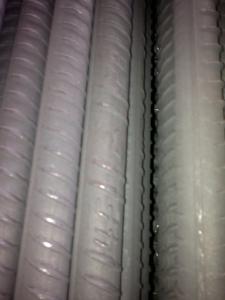Steel Wire Rod China Manufacturer Hot Rolled in Coils
- Loading Port:
- Tianjin
- Payment Terms:
- TT or LC
- Min Order Qty:
- 30 m.t.
- Supply Capability:
- 30000 m.t./month
OKorder Service Pledge
OKorder Financial Service
You Might Also Like
Product Description:
OKorder is offering Steel Wire Rod China Manufacturer Hot Rolled in Coils at great prices with worldwide shipping. Our supplier is a world-class manufacturer of steel, with our products utilized the world over. OKorder annually supplies products to European, North American and Asian markets. We provide quotations within 24 hours of receiving an inquiry and guarantee competitive prices.
Product Applications:
Steel Wire Rod China Manufacturer Hot Rolled in Coils are ideal for structural applications and are widely used in the construction of buildings and bridges, and the manufacturing, petrochemical, and transportation industries.
Product Advantages:
OKorder's Steel Wire Rod China Manufacturer Hot Rolled in Coils are durable, strong, and resist corrosion.
Main Product Features:
· Premium quality
· Prompt delivery & seaworthy packing (30 days after receiving deposit)
· Corrosion resistance
· Can be recycled and reused
· Mill test certification
· Professional Service
· Competitive pricing
Product Specifications:
1.Standard: AISI,ASTM,BS,DIN,GB,JIS
2.Wire Gauge: 5.5~14mm
3.Model Number: Q195, Q235, SAE1006, SAE1008
4.MOQ:25MT
Grade | Chemical Composition(%) | |||||
C | Mn | Si | S | P | B | |
SAE1006B | 0.03~O.07 | ≤0.32 | ≤0.30 | ≤0.045 | ≤0.040 | >0.0008 |
Mechanical properties | ||||||
Yield strength(N/mm2) | Tensile strength(N/mm2) | Elongation(%) | ||||
250-280 | 350-380 | ≥32 | ||||
Grade | Chemical Composition(%) | |||||
C | Mn | Si | S | P | B | |
SAE1008B | 0.10max | 0.3~O.50 | 0.15max | 0.050max | 0.040 max | 0.0008 min |
Mechanical properties | ||||||
Yield strength(N/mm2) | Tensile strength(N/mm2) | Elongation(%) | ||||
≥195 | 315-430 | ≥30 | ||||
Grade | Chemical Composition(%) | |||||
C | Mn | Si | S | P | B | |
Q195B | 0.06~O.12 | 0.25~O.50 | ≤0.30 | ≤0.050 | ≤0.045 | >0.0008 |
Mechanical properties | ||||||
Yield strength(N/mm2) | Tensile strength(N/mm2) | Elongation(%) | ||||
≥195 | 315-430 | ≥33 | ||||
Grade | Chemical Composition(%) | |||||
C | Mn | Si | S | P | B | |
Q235B | 0.12~O.2 | 0.3~O.701 | ≤0.30 | ≤0.045 | ≤0.045 | >0.0008 |
Mechanical properties | ||||||
Yield strength(N/mm2) | Tensile strength(N/mm2) | Elongation(%) | ||||
235 | 375-500 | ≥26 | ||||
FAQ:
Q1: Why buy Materials & Equipment from OKorder.com?
A1: All products offered byOKorder.com are carefully selected from China's most reliable manufacturing enterprises. Through its ISO certifications, OKorder.com adheres to the highest standards and a commitment to supply chain safety and customer satisfaction.
Q2: How do we guarantee the quality of our products?
A2: We have established an advanced quality management system which conducts strict quality tests at every step, from raw materials to the final product. At the same time, we provide extensive follow-up service assurances as required.
Q3: How soon can we receive the product after purchase?
A3: Within three days of placing an order, we will begin production. The specific shipping date is dependent upon international and government factors, but is typically 7 to 10 workdays.
Q4: What makes stainless steel stainless?
A4: Stainless steel must contain at least 10.5 % chromium. It is this element that reacts with the oxygen in the air to form a complex chrome-oxide surface layer that is invisible but strong enough to prevent further oxygen from "staining" (rusting) the surface. Higher levels of chromium and the addition of other alloying elements such as nickel and molybdenum enhance this surface layer and improve the corrosion resistance of the stainless material.
Q5: Can stainless steel rust?
A5: Stainless does not "rust" as you think of regular steel rusting with a red oxide on the surface that flakes off. If you see red rust it is probably due to some iron particles that have contaminated the surface of the stainless steel and it is these iron particles that are rusting. Look at the source of the rusting and see if you can remove it from the surface.
Images:
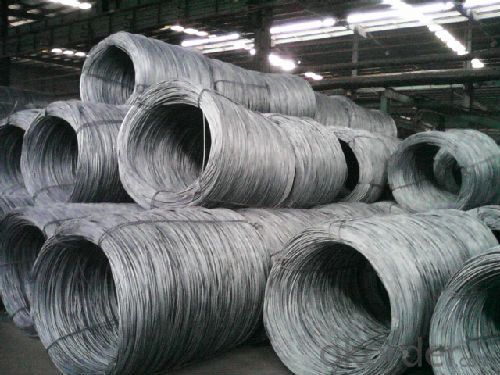
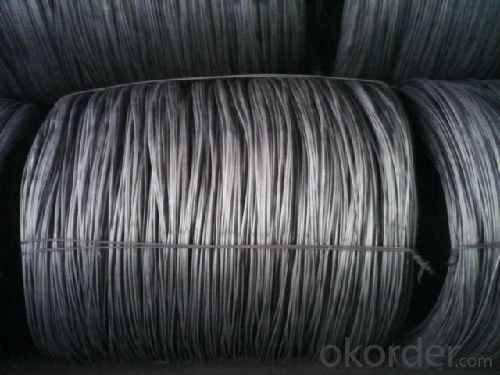
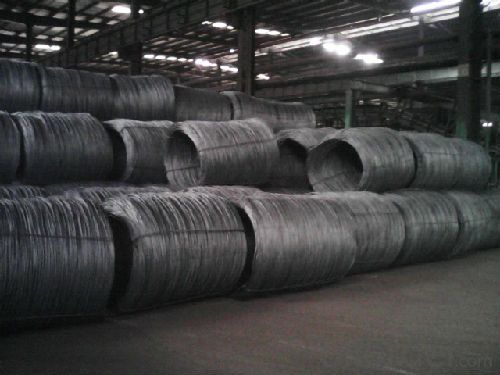
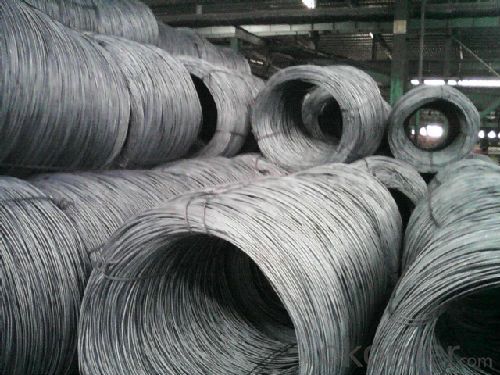
- Q: How does the tensile strength of steel wire rod vary with different diameters?
- The tensile strength of steel wire rod generally increases with larger diameters. This is because the larger diameter allows for more material, resulting in a higher capacity to withstand tension before breaking. However, it is important to note that other factors such as the specific alloy composition, manufacturing process, and heat treatment can also affect the tensile strength of steel wire rods.
- Q: How is steel wire rod used in the production of fences?
- Steel wire rod is commonly used in the production of fences as it serves as the primary material for manufacturing the wires that form the structure of the fence. These rods are first drawn into thin wires, which are then woven, welded, or twisted together to create the fence's mesh or chain-link pattern. The high strength and durability of steel wire rod make it ideal for withstanding weather conditions and providing security. Additionally, it can be coated with protective materials such as zinc or PVC to further enhance its resistance to corrosion and increase its lifespan.
- Q: What are the different production processes involved in steel wire rod manufacturing?
- The manufacturing of steel wire rods involves several production processes. These processes are crucial in transforming raw materials into the final product. Here are the different production processes involved in steel wire rod manufacturing: 1. Ironmaking: The steel wire rod manufacturing process begins with ironmaking. Iron ore is extracted and processed in a blast furnace to produce pig iron. The pig iron is then further refined to remove impurities and create steel. 2. Steelmaking: In the steelmaking process, the pig iron is melted in a furnace and alloyed with various elements such as carbon, manganese, and silicon to achieve the desired steel properties. This process ensures that the steel meets the specific requirements of wire rod production. 3. Continuous Casting: After steelmaking, the molten steel is cast into billets or blooms using continuous casting technology. This process involves pouring the molten steel into a water-cooled mold to solidify it into a specific shape. For wire rod production, the billets are typically cast in a square cross-section. 4. Hot Rolling: The next step is hot rolling, where the billets are reheated and passed through a series of rolling mills. These rolling mills reduce the billets' cross-sectional area and elongate them into wire rod form. The hot rolling process improves the mechanical properties and surface finish of the wire rods. 5. Cooling: Once the wire rods are hot rolled, they undergo a cooling process to achieve the desired properties. Cooling can be done through air cooling or water spray cooling, depending on the specific requirements of the wire rods. 6. Surface Treatment: After cooling, the wire rods undergo surface treatment processes such as pickling or coating. Pickling involves removing any scale or oxide on the surface of the wire rods using acid solutions. Coating may involve applying a protective layer to prevent corrosion or improve the wire rods' performance in specific applications. 7. Inspection and Quality Control: Throughout the manufacturing process, the wire rods undergo rigorous inspection and quality control measures. This ensures that the wire rods meet the required standards and specifications. Various tests, such as tensile strength, elongation, and dimensional checks, are conducted to ensure the quality of the wire rods. 8. Packaging and Delivery: Finally, the wire rods are packaged according to customer requirements and prepared for delivery. They may be bundled, coil-wound, or packaged in other forms, depending on the customer's needs. The wire rods are then transported to the customers, where they can be further processed or used in various applications. These production processes play a vital role in the manufacturing of steel wire rods, ensuring that they meet the required specifications and are suitable for different applications in industries such as construction, automotive, and manufacturing.
- Q: How is steel wire rod stored and handled to prevent corrosion?
- To minimize the risk of corrosion, steel wire rod is typically stored and handled in a manner that takes certain precautions. Firstly, it is stored in a dry and well-ventilated location to prevent the accumulation of moisture, which can hasten corrosion. Additionally, the storage area is shielded from direct exposure to rain or other sources of water. To further prevent contact with moisture, steel wire rods are often stored off the ground using racks or pallets. This not only keeps them away from any moisture that may be present on the floor but also allows for better airflow around the stored material, reducing the likelihood of corrosion. Moreover, a protective layer is commonly applied to the steel wire rods, such as oil or a corrosion-resistant coating. This coating acts as a barrier, preventing direct contact between the metal and the surrounding environment. By inhibiting the oxidation process, it safeguards the rods from corrosive elements. During the handling process, it is crucial to use appropriate equipment such as cranes, forklifts, or other lifting devices to minimize the risk of physical damage. Any scratches or dents on the surface of the wire rod can compromise the protective coating and increase the chances of corrosion. Regular inspections are essential to identify any indications of corrosion or damage. If any issues are found, immediate measures should be taken to prevent further deterioration. This may involve reapplying the protective coating or treating the affected area with rust inhibitors. In conclusion, the storage and handling of steel wire rods follow specific practices to minimize the risk of corrosion. By storing the rods in a dry and well-ventilated area, elevating them off the ground, applying protective coatings, using appropriate handling equipment, and conducting regular inspections, the potential for corrosion can be significantly reduced.
- Q: How is steel wire rod tested for chemical composition?
- Steel wire rod is tested for chemical composition through a process called spectrometry, which involves analyzing the elemental composition of the rod. This is typically done by taking a small sample of the rod and subjecting it to a spectrometer, which measures the intensity of light emitted by the elements present in the sample. By comparing these measurements to known standards, the composition of the steel wire rod can be accurately determined.
- Q: How is steel wire rod used in the manufacturing of wire for jewelry making?
- Steel wire rod is used in the manufacturing of wire for jewelry making as it provides strength, durability, and flexibility. The steel wire rod is drawn through a series of dies to achieve the desired thickness and shape of the wire. This wire is then used to create various components of jewelry such as chains, findings, clasps, and intricate designs. The high-quality steel wire rod ensures that the jewelry is sturdy and can withstand everyday wear and tear, making it an essential material in jewelry manufacturing.
- Q: How is steel wire rod used in the manufacturing of wire forms for filtration systems?
- Steel wire rod is used in the manufacturing of wire forms for filtration systems as it serves as the raw material for creating various wire shapes and sizes. The wire rod is first processed through a series of steps, such as drawing and annealing, to achieve the desired mechanical properties and surface finish. Then, it is further transformed into wire forms, such as screens, meshes, and baskets, which are crucial components in filtration systems. These wire forms provide the necessary strength, durability, and precision required to effectively filter and separate particles or impurities from fluids or gases in different industrial processes.
- Q: What are the different types of steel wire rod defects that can occur during manufacturing?
- Some of the different types of steel wire rod defects that can occur during manufacturing include surface defects such as scale, cracks, and scratches, internal defects like inclusions, voids, and segregation, dimensional defects such as variations in diameter or ovality, and mechanical defects like twists, bends, or straightness issues. These defects can affect the quality and performance of the steel wire rod and may require proper inspection and quality control measures to prevent or minimize their occurrence.
- Q: How is steel wire rod used in the manufacturing of wire forms for sliding doors?
- Steel wire rod is used in the manufacturing of wire forms for sliding doors as it provides the necessary strength and durability required for these applications. The steel wire rod is shaped and formed into various wire forms such as tracks, brackets, and hinges, which are essential components of sliding doors. These wire forms help to ensure smooth and effortless movement of the doors, providing stability and support.
- Q: How are steel wire rods used in the manufacturing of piano strings for musical instruments?
- Steel wire rods are an essential component in the manufacturing of piano strings for musical instruments. These wire rods are typically made of high-quality steel that is carefully engineered to provide the desired properties for piano strings. The first step in utilizing steel wire rods is to draw them through a series of dies to reduce their diameter and increase their tensile strength. This process, known as wire drawing, ensures that the steel wire rods are strong enough to withstand the tension required for piano strings. Once the steel wire rods have been drawn to the desired size, they are further processed to form the individual piano strings. The wire is cut into specific lengths and then coiled to create the desired shape and size for each string. These coils are then wound around a core wire, which provides stability and enhances the tonal quality of the string. The use of steel wire rods in piano string manufacturing is crucial for several reasons. Firstly, steel is known for its durability and resistance to stretching, making it ideal for withstanding the constant tension and pressure exerted on piano strings. Additionally, steel wire rods have excellent flexibility, allowing the strings to vibrate freely and produce a rich, resonant sound. Moreover, the precise manufacturing process of steel wire rods ensures that the resulting piano strings have consistent quality and uniformity. This is crucial for maintaining the integrity and balance of sound across the entire piano keyboard. In conclusion, steel wire rods play a vital role in the manufacturing of piano strings. Their strength, flexibility, and precision make them an ideal material for producing high-quality strings that can withstand the demanding requirements of a piano.
Send your message to us
Steel Wire Rod China Manufacturer Hot Rolled in Coils
- Loading Port:
- Tianjin
- Payment Terms:
- TT or LC
- Min Order Qty:
- 30 m.t.
- Supply Capability:
- 30000 m.t./month
OKorder Service Pledge
OKorder Financial Service
Similar products
Hot products
Hot Searches
Related keywords

